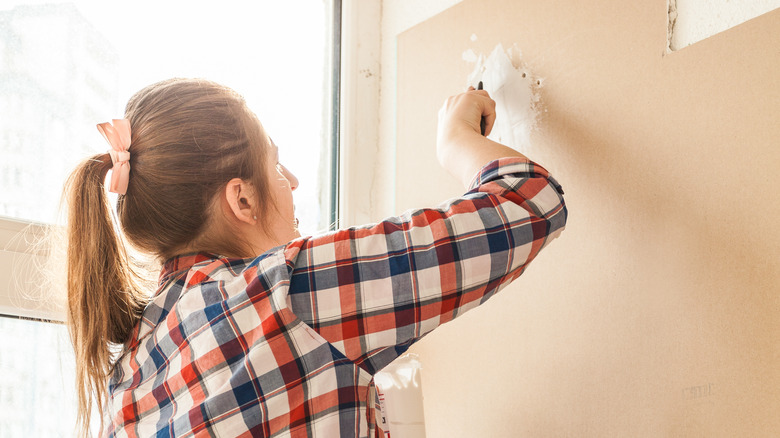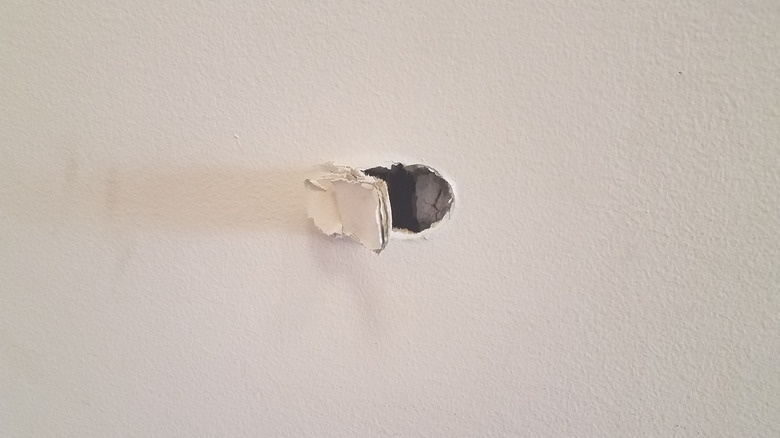The Unexpected Item TikTok DIYers Prefer Using Over A Putty Knife
Staring at an annoying spot on your wall that needs fixing, but don't have the proper putty knife for the job? Whether you're looking at holes, cracks, bubbles, or other types of damage, there's an easy way to fix that uneven drywall with a simple tool that's already located in your wallet: a plastic card.
Instead of having to buy a new tool for your kit, TikTok DIYer @sandra.maria.home shows how this simple fix can be made with whatever sturdy plastic card you have in your back pocket. A plastic card is a bit more flexible compared to a putty knife, making it an even more effective tool for being able to create an even spread of that spackle. Plus, rinsing the spackle off the plastic is a breeze. So, here's how to fix the uneven eye sores on your wall with a plastic card, a bucket of spackle, and a few spare minutes of your time. Don't have spackle, either? You can make a substitute for spackle with items in your pantry.
How to fix wall damage with a plastic card
To get started, remove any air bubbles or uneven pieces of cracking dry wall. The best way to remove is by peeling it with your finger, or carefully using a small knife to slice through the bubbles and rip off the uneven pieces. Experts recommend using a fine-grit sandpaper to smooth down the edges around a damaged area so there aren't any protruding fragments. When the damaged area is bubble free and smooth, this is where your trusty plastic card comes in handy. Choose a plastic card that is flat without any embossed letters or numbers. Dollop some of the spackle onto your card like you would to a putty knife. Slide the spackle onto the damaged area, using the edges to smooth and flatten things out.
Wait for the spackle to completely dry until continuing; this should take between one and two hours. If you're using pink spackle, when the pink turns into white, it's ready for sanding. In some cases, the spackle may depress into the wall and create an uneven surface. If this happens, apply the spackle again until the wall is even. When it's ready, sand down the area until you can run a finger across the wall smoothly without knowing where the painted wall and the spackled area begins or ends. Once it's smooth, clean the drywall dust in the surrounding area and get ready to paint!
Other clever ways to fix drywall damage
If you're dealing with other types of wall damage beyond an air bubble or a crack in the drywall, there are many clever ways to fix those holes using tools you likely already have at home before breaking out your spackle and plastic card. If you have a hole in the wall the size of a quarter, there is a drywall repair hack that works using a cosmetic beauty sponge. The small sponge can be used to plug a gap in the hole, then once the entire area is covered, you can spackle. Bigger holes can be patched up using pieces of scrap wood.
For filling larger damaged areas, Ethan James from The Honest Carpenter recommends using joint compound — otherwise known as "drywall mud" — instead of spackle. But can you still spread joint compound using a plastic card? While it is possible to smooth out drywall mud with that card, be warned; things could get messy. Spackle is more elastic and easier to push around with a small plastic card, while joint compound is looser and can get messy if you're working with a lot of it. So, consider the size of the repair before deciding if buying a putty knife is needed, or if the damage is small enough to fix with a plastic card.

